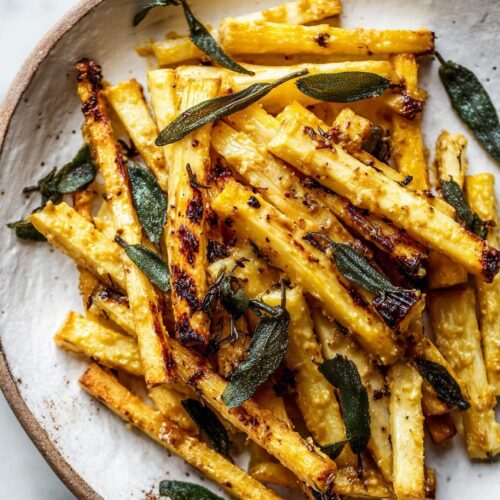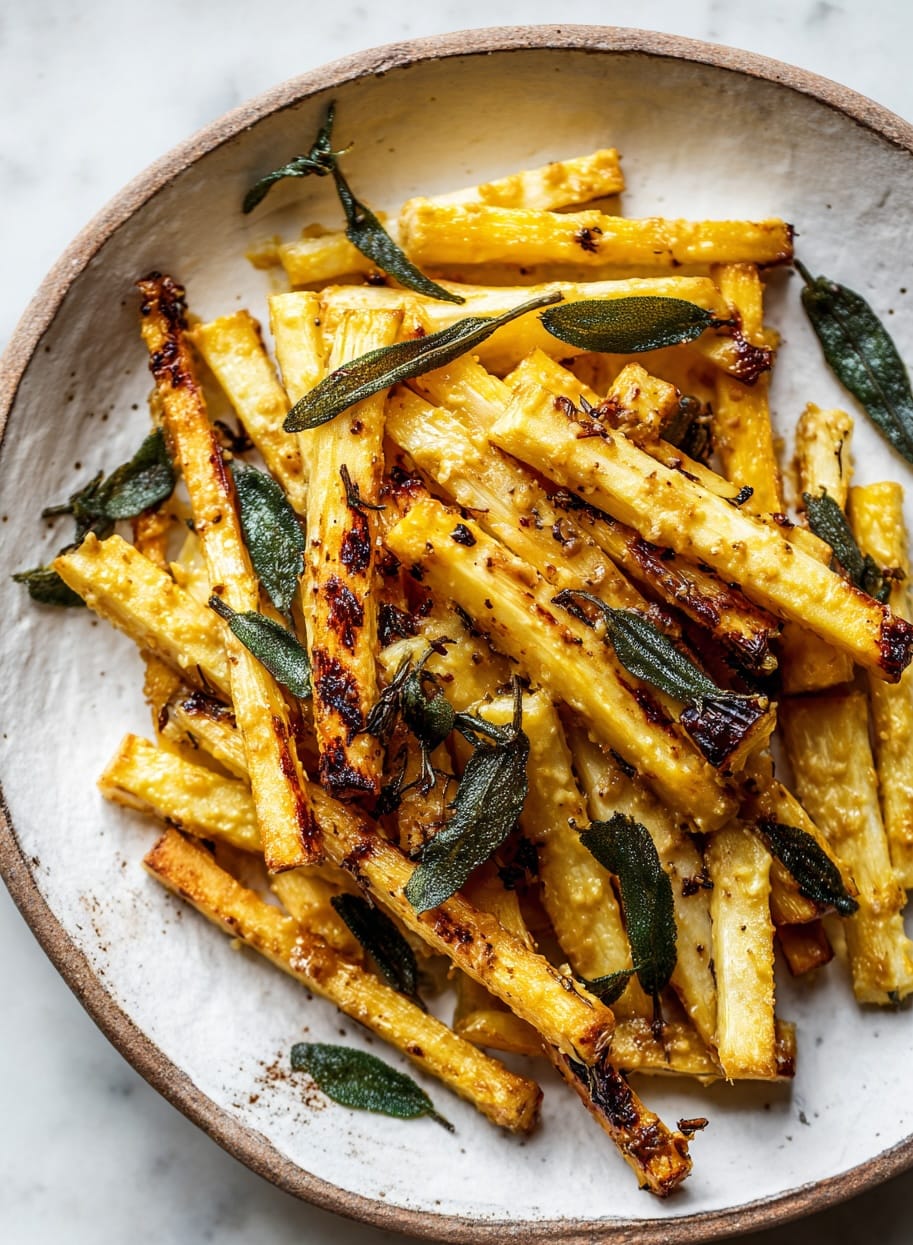Mustard and sage work perfectly with parsnips
Parsnips have this natural sweetness that begs for something sharp to cut through it. Mustard is just the thing. It adds a tangy kick that keeps each bite lively, while sage brings an earthy depth that makes the whole dish feel cosy and autumnal. Together, they transform simple roasted roots into a side dish with character.
This is one of those recipes that feels both rustic and elegant, making it as fitting for a casual midweek meal as it is for a festive roast. If you’re in the mood to explore other combinations that make parsnips shine, have a look at our 7 best roasted parsnip recipes for more inspiration.
A glaze that adds tang and fragrance
I like to use wholegrain mustard here, it has a gentle bite, tiny seeds that pop, and a mellow warmth that builds with roasting. When combined with a drizzle of oil, it forms a glaze that clings to the parsnips, ensuring each piece picks up flavour. Fresh sage leaves crisp up in the oven, giving little bursts of savoury herbiness.
The beauty of this recipe lies in its balance. Sweet, tangy, and earthy notes all show up in harmony. For more pairings like this that elevate simple ingredients, the ultimate guide to parsnip recipes has plenty of ideas.
Ingredients (serves 4)
- 750 g parsnips, peeled and cut into batons
- 2 tbsp olive oil
- 2 tbsp wholegrain mustard
- 10 fresh sage leaves
- 1 tsp honey (optional, for extra caramelisation)
- Sea salt, to taste
- Black pepper, freshly ground
How to make roast parsnips with mustard and sage
Pre-heat the oven
Preheat the oven to 200°C (fan 180°C). Place a baking tray inside to heat up.
Glaze the parsnips
Peel and cut the parsnips into batons. In a large bowl, whisk together olive oil, mustard, salt and pepper. Toss the parsnips until coated.
Roast the parsnips with sage
Spread the parsnips on the hot tray in a single layer. Scatter the sage leaves over the top. Roast for 30–35 minutes, turning halfway, until golden brown and crisp around the edges. Drizzle with a little honey at the end if you’d like extra stickiness.
Wine and beer pairings
The tang of mustard and the herbal lift of sage make these parsnips a lovely match for Chablis. Its minerality cuts through the sweetness while echoing the earthiness of sage. A Pinot Gris is another good option, adding round fruit notes that soften the mustard’s sharpness.
For beer, I’d choose a pilsner — crisp, clean, and refreshing against the richness of roasted roots. A saison is also excellent, its subtle spice and farmhouse character mirroring the complexity of sage and mustard.
Frequently asked questions about parsnips
Can I make this with dried sage?
Yes, though fresh leaves crisp beautifully in the oven. If using dried, add half a teaspoon to the glaze mixture instead of scattering on top. For more herb-led inspiration, see my maple glazed parsnips with rosemary recipe.
Can I make this vegan?
It already is, as long as you skip the optional honey. Maple syrup makes a great alternative if you’d still like a touch of sweetness. If you’re after more vegan parsnip recipes, try the sticky soy and ginger roast parsnips next.
What’s the nutritional value of mustard-glazed parsnips?
They’re full of fibre and vitamins, and mustard adds antioxidants without adding much fat or sugar. You can read a deeper breakdown in the are parsnips good for you? nutrition guide where I’ve listed everything in detail.
Can I serve this cold?
Yes. They’re lovely in grain salads or tossed into couscous once cooled. The mustard holds up well even when chilled. If you’d like more serving ideas, check out spiced roast parsnips with cumin and coriander.
Tips for success
Don’t drown the parsnips in mustard — a light coating goes a long way. Too much and it can overwhelm the natural sweetness. Make sure the sage leaves aren’t buried under the parsnips; they crisp best when sitting on top and exposed to heat.
Storage and reheating
Keep leftovers in the fridge in a sealed container for up to three days. Reheat in a hot oven until warmed through and crisp. They can also be diced and stirred into omelettes or mixed into grain bowls for a quick lunch.
Ingredient notes and alternatives
Wholegrain mustard is best, but Dijon can be used if you want a sharper edge. Fresh sage is ideal for crisping, but dried works in a pinch. A drizzle of maple syrup instead of honey keeps it vegan while adding sweetness.

Roast parsnips with mustard and sage
Ingredients
- 750 g Parsnips peeled and cut into batons
- 2 tbsp Olive oil extra virgin
- 2 tbsp Wholegrain Mustard
- 10 Fresh sage leaves
- 1 tsp Honey runny
- Sea salt to taste
- Black pepper freshly ground, to taste
Instructions
- Preheat the oven to 200°C (fan 180°C). Place a baking tray inside to heat up.
- Peel and cut the parsnips into batons. In a large bowl, whisk together olive oil, mustard, salt and pepper. Toss the parsnips until coated.
- Spread the parsnips on the hot tray in a single layer. Scatter the sage leaves over the top. Roast for 30–35 minutes, turning halfway, until golden brown and crisp around the edges. Drizzle with a little honey at the end if you’d like extra stickiness.

